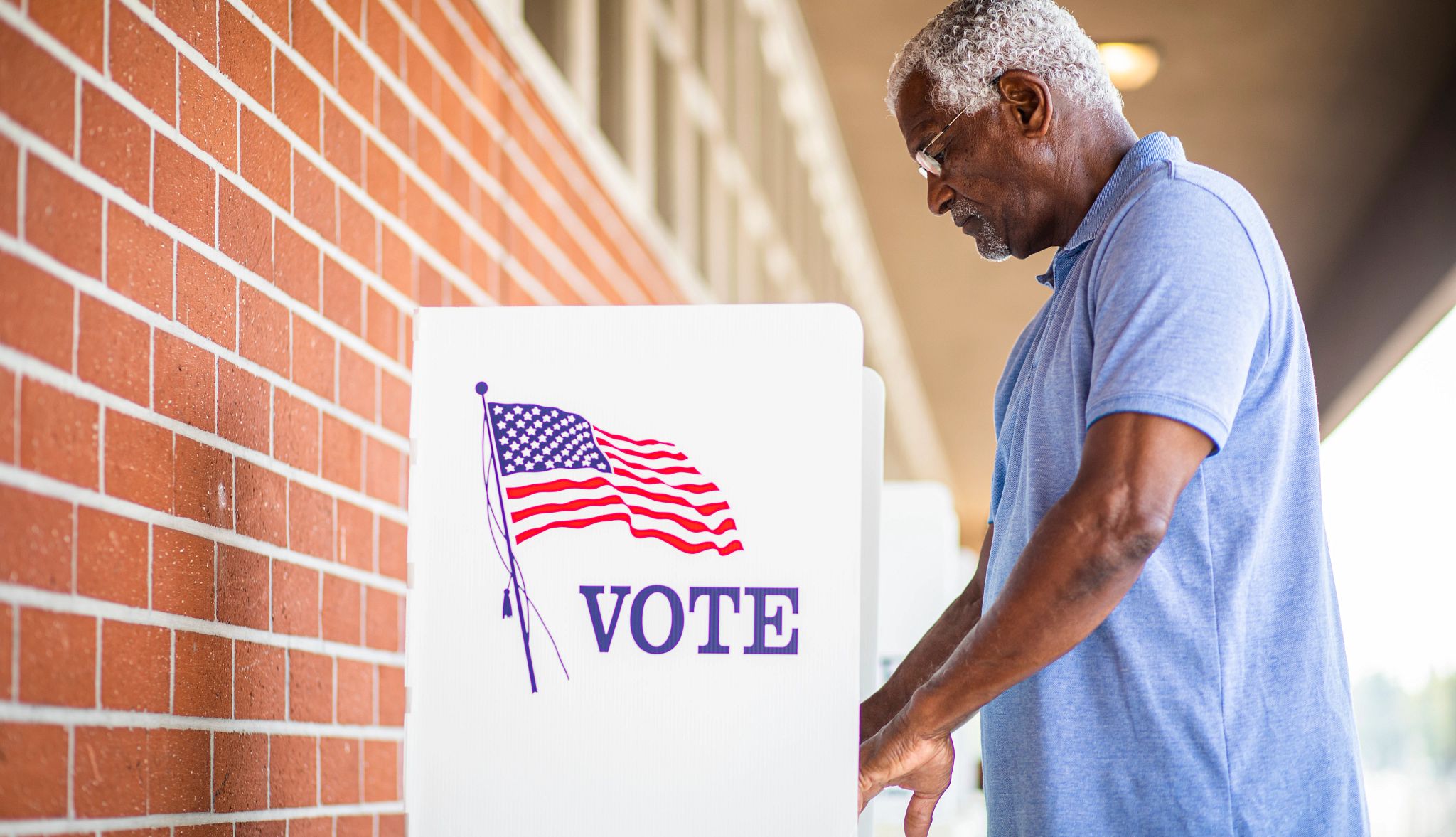AARP Hearing Center

Voting after hurricanes
Election officials in counties hit hardest by Hurricanes Helene and Milton are permitted to allow certain changes to voting, according to executive orders issued by Gov. Ron DeSantis. For example, officials can move voting locations and displaced voters can request a vote-by-mail ballot at their new location. The impacted counties are: Charlotte, Citrus, Collier, Dixie, Glades, Hernando, Highlands, Hillsborough, Indian River, Lee, Levy, Madison, Manatee, Orange, Pasco, Pinellas, Polk, Sarasota, St. Lucie and Taylor. Voters should contact their county supervisor of elections for more detailed information. Changes to voting are also reflected in this guide.
Important dates
- Deadline to register to vote: Monday, Oct. 7
- Deadline to request a vote-by-mail ballot be sent to you: Thursday, Oct. 24, by 5 p.m.
- Early voting: Saturday, Oct. 26, through Saturday, Nov. 2
- Deadline for counties to receive vote-by-mail ballots: Tuesday, Nov. 5, by 7 p.m.
- Election Day: Tuesday, Nov. 5
Voting at a glance
- Voter registration: Check your registration status using the state’s voter information tool.
- By-mail voting: All registered voters can request a no-excuse vote-by-mail ballot.
- Early voting: Counties must open early in-person voting at least 10 days before Election Day, though some may open earlier.
- Voting at the polls: Polls are open from 7 a.m. to 7 p.m. Bring a valid form of ID with a signature, such as a current Florida driver’s license, on Election Day or to an early voting location.
Recent voting changes in Florida
- Accommodations are available for election officials and voters impacted by Hurricane Helene and Hurricane Milton due to executive orders issued by Gov. Ron DeSantis. A summary of the orders is available here.
- Voters who had a standing vote-by-mail ballot request will no longer get those automatically. If you want a vote-by-mail ballot, you must submit a new request each election cycle.
- Redistricting in 2022 may affect which candidates appear on your ballot. Litigation over the state’s congressional districts is ongoing. Check back for updates.
How to register to vote
Register by mail, in person or online. Voters must be registered by Monday, Oct. 7.
- Online: Use the state’s voter registration portal to register, check your registration status or update your registration information. You’ll need a Florida driver’s license or state-issued ID card, the issue date of your license or ID, and the last four digits of your Social Security number. If you do not have that information, you may still use the online system to prefill a voter registration application form. However, you will have to print, sign and mail or deliver your voter registration application to your county supervisor of elections.
- By mail: Print a voter registration form, complete it and mail it to your county supervisor of elections.
- In person: Go to your county supervisor of elections office to pick up, drop off or fill out a registration form. Forms are also available at public libraries and offices authorized by the Florida Fish and Wildlife Conservation Commission to issue fishing, hunting or trapping permits.
Registering to vote on Election Day
Florida law does not allow registration on Election Day.
Check your voter registration status
Use the state’s voter information tool to check your registration status.
How to request a vote-by-mail ballot
Any registered voter can request a no-excuse vote-by-mail ballot. You’ll need to submit a new request each year. The deadline to request that a ballot be mailed is Thursday, Oct. 24, for the general election. When making your request, include your full name, address, date of birth and a copy of your Florida driver’s license or state-issued ID card — or the last four digits of your Social Security number. Written requests must include your signature.
- Online: Check your county supervisor of elections website for ballot request forms.
- By mail, fax or email: Send a letter, email, scanned attachment or fax to your county supervisor of elections asking that a ballot be sent to you.
- By phone: Call your county supervisor of elections.
- In person: Visit your county supervisor of elections.
You can designate an immediate family member — such as a spouse, parent or child — to request a ballot on your behalf. They’ll need to provide your information along with their name, address, relationship to you and driver’s license number.
The deadline to request a ballot be mailed to you for the general election is Thursday, Oct. 24 by 5 p.m. You can still request a vote-by-mail ballot in person at your county supervisor of elections office after this date if an emergency prevents you from going to an early voting site or the polls on Election Day. You’ll be asked to sign an emergency affidavit. The deadline to pick up a vote-by-mail ballot in person is 7 p.m. on Election Day, Tuesday, Nov. 5.
You may have someone else pick up your ballot if they complete a separate affidavit. That person is limited to collecting two ballots for non-family members per election, though there is an exception for those picking up ballots for voters with disabilities.
There are different deadlines for overseas and military voters on the elections website.
Returning a vote-by-mail ballot
Election officials must receive completed ballots by Election Day, Tuesday, Nov. 5, at 7 p.m. Ballots can be returned:
- By mail: Follow the instructions included with your voting materials to complete and mail your ballot. Leave at least a week for your ballot to make it through the mail.
- In person: Drop your completed ballot at a secure ballot intake station at your county supervisor of elections office or an early voting location. Contact your county supervisor of elections or refer to their website for the locations of all ballot intake stations in your county.
For voters in counties under Hurricane Helene’s executive order, the locations of secure ballot intake stations for the general election should now be available (as they were slated to become public by Wednesday, Oct. 16). For voters in counties under Hurricane Milton’s order, locations should become public by Saturday, Oct. 26. Contact your county supervisor of elections if you’re unsure of where to drop your ballot.
In Pinellas and Taylor counties, some secure ballot intake stations are permitted to remain open through Monday, Nov. 4, instead of the standard Saturday, Nov. 2.
Use the state’s vote-by-mail information portal to track the status of your vote-by-mail ballot.
Vote-by-mail voters impacted by hurricanes
If you are displaced and want to vote by mail for the general election, contact your county supervisor of elections. Under the executive orders, voters in counties impacted by Hurricanes Helene and Milton may have their mail ballots sent to an address other than the one listed on their voter registration without having to submit a signed written request. You still need to provide your Florida driver's license number, state ID number, or the last four digits of your Social Security number. Election officials under Hurricane Helene’s order must mail ballots within two business days of receiving a request, and officials under Hurricane Milton’s order must mail ballots by at least Saturday, Oct. 26.
If you already requested a mail ballot for the general election, but need a new one because yours is lost, damaged or inaccessible, contact your county supervisor of elections to request a new one.
If you already requested a mail ballot but would now prefer to vote in person, you can do so at an early voting location or your polling place (as long as your ballot hasn’t already been returned and received by your county supervisor of elections office). Bring your mail ballot to the in-person voting location if you have it. If not, election officials will need to confirm your ballot hasn’t already been returned and received. If they can’t confirm, you can still vote using a provisional ballot.
Voting in person before Election Day
All counties must let voters cast ballots early and in person beginning at least 10 days before an election. The mandatory early voting period is Saturday, Oct. 26, to Saturday, Nov. 2, for the general election. Some counties may offer additional early voting days. Check with your county supervisor of elections for exact times and locations.
For voters in counties under Hurricane Helene’s or Hurricane Milton’s executive orders, locations and opening hours of early voting centers may change for the general election. However, election supervisors should have posted any changes by Wednesday, Oct. 16, for counties under Hurricane Helene’s order, and should post any changes by Saturday, Oct. 26, or two days before use (whichever is earlier), for counties under Hurricane Milton’s. Check with your county supervisor of elections if you are unsure of where to go.
In Pinellas and Taylor counties, some early voting locations are permitted to open through Monday, Nov. 4, instead of the standard Saturday, Nov. 2.
Voting at the polls on Election Day
The polls are open from 7 a.m. until 7 p.m. for the general election. You'll be allowed to cast a ballot after polls close as long as you were in line beforehand. Use the state's voter information portal or the state’s Voter Precinct Lookup page to find your polling place.
For voters in counties under Hurricane Helene’s or Hurricane Milton’s executive orders, your polling place may change for the general election. Any changes should be reflected on the state's voter information portal and the state’s Voter Precinct Lookup page, but contact your county supervisor of elections if you are unsure of where to go.
Check your county supervisor of elections website for sample ballots.
Voter ID requirements on Election Day
You will need to bring a current and valid form of ID such as a state-issued driver’s license, military ID or a U.S. passport, whether you’re voting on Election Day or at an early voting location.
If your photo ID does not include your signature, you will be asked to provide another ID that includes your signature.
If you do not bring proper ID, you can vote a provisional ballot. As long as you are eligible and voted in the proper precinct, your provisional ballot will count, provided the signature on your provisional ballot matches the signature in your registration record.
Voting with a disability
At least one accessible voting system is available in each polling place during early voting and on Election Day.
Voters with disabilities may receive help while voting, as long as that assistance does not come from an employer, an employer’s agent or a union official.
Voters with disabilities may also get an accessible vote-by-mail ballot. Visit the Florida Division of Elections website for more information.
Voting from a nursing home or long-term care facility
For residents of assisted living facilities and nursing homes, a team from the supervisor of elections’ office can deliver ballots and supervise voting on-site at the request of their health facility’s administrator.
Editor’s note: This guide was originally published on Jan. 29, 2024, and was updated on Oct. 18, 2024, with information on how to vote after hurricanes.
Michelle Tuccitto Sullo is a states writer and editor for AARP. She previously served as managing editor of the Hartford Business Journal in Connecticut and has also worked for the New Haven Register, the Connecticut Law Tribune and New Haven Biz.
Emily Paulin is a reporter for AARP covering nursing homes, health care, and federal and state policy. Her work has also appeared in Broadsheet, an Australian lifestyle publication.































































